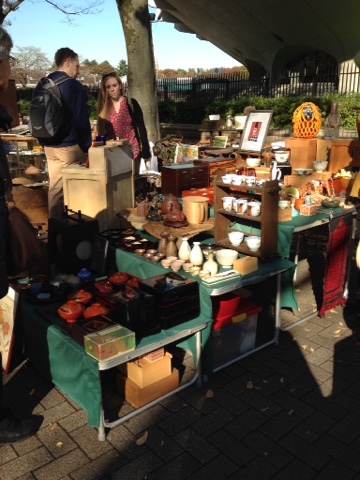Sunday, December 6, 2015
Saturday, November 28, 2015
Japanese Shrine, Temple and Flea Markets
Throughout Japan there are weekly, monthly and annual markets. If you are going to be in Japan check on line if any of these sales will be going on during your visit. You can "haggle" a bit and go home with a few treasures at reasonable prices.
Thursday, November 19, 2015
SOBA CHOKO
Soba choko are for dipping sauce for buckwheat noodles. They have been around since the Edo period. There are many styles, shapes and sizes.
Saturday, October 31, 2015
"Collecting Japanese Ceramics and Arts" Facebook Group
For those wishing additional help consider joining The Facebook Group "Collecting Japanese Ceramics and Arts". You must apply under your personal FB page with no banner displaying a business. This group is educational and does not allow buying, selling, advertising nor does it give valuations. It is a great group with many knowledgable people who volunteer their time to help people identify their pieces.
If you belong to a lot groups (100+) you will probably will not get in, as the group wants people who are serious about learning about Japanese ceramics.
Wednesday, October 28, 2015
Friday, October 16, 2015
Toby Mugs
Toby mugs (jugs) originated in Great Britain but it seems like there are renditions of the themed mugs from many countries. I have seen the real Royal Doulton mugs and really there is no comparison!
Japan produced a large amount of these mugs, some marked Made In Japan and others Made in Occupied Japan. Many are marked Wales China.
Friday, September 25, 2015
ANTIQUE SETO YAKI
KATO SHUNKO (sometimes incorrectly read as Harumitsu)
加藤春光
Link: http://blog.livedoor.jp/momo2011/archives/3887320.html
KATO GOSUKE
陶玉園 加藤五助
Tougyokuen Kato Gosuke
TAKEUCHI CHUBEI (竹内忠兵衛)
Chubei was noted for his sharkskin glazes, but also for his cloisonné. Many of his sharkskin wares are marked with a number read right to left 五一五二五二二 or left to right 2252515 which is a patent number, Meiji 22 (1890) 5 month 25 day for 15 years (from worthpoint). This mark was used circa 1890-1905.
See:
Yamatouen Sei
松村九助氏 Matsumura Kusuke 1844-1912 Nagoya
Links:
Wednesday, September 16, 2015
Tuesday, September 15, 2015
IGEZARA-The pie crust plates
Igezara are thickly potted transferware plates, usually with a brown pie crust rim. These were made in the Meiji through the early Showa period. The name is derived from a dialect in Saga Prefecture meaning thorn plates. These were made for the common people for everyday ware. Many are unmarked but there are some makers who did mark their wares.
So far I have found these marks used on Igezara
Iwa mark 岩
Ken mark 謙
Koransha mark コオラン
Kushiyama mark 串山
Shiroiwa 城岩
Tomi or Yutaka mark 豊
Uwataki mark 上瀧
Yamatoku 山徳
There are various common motifs.
This Igezara has the book shape forming a window or canvas for the decoration with the bamboo motif in the background. Inside the book shape are moon, plum blossoms, peony and a rock. It is 31cm in diameter.
It appears that most Igezara were made during the late Meiji through Taisho period.
Thursday, September 10, 2015
KYOTO SATSUMA (京 薩摩)
 |
| From collection of Jim Horne |
AWATA YAKI (粟田焼)
This is an Awata Jar with missing lid c. 1930
KINKOZAN
Made for export. This mark (red and gold) with the mountain mark reads Kinkozan Zo 錦光山造. This is probably c. 1921-1930 ( certainly after September 1921, given the MIJ written above the mark).
Marked Kinkozan Zo. These kinds of cups (and saucers) came in sets of twelve, a different flower motif for each month.
KOSHIDA
Subscribe to:
Posts (Atom)
Featured Post
Helpful Vocabulary When Researching Japanese Ceramics
Vocabulary when searching for Japanese Ceramics *I will be adding to this list Dating ( 江戸) Edo Period (1603-1868) (江戸 前期) Ea...
-
From 1921-1941, wares from Japan exported to the United States had to be marked "Japan" or "Made in Japan". During Wor...
-
Kutani ware is from Ishikawa Prefecture. The markings are often in red, but can be impressed, in blue, gold and sometimes black with a g...
-
The This company was in business from 1954-1994. It was bought out by Enesco in 1994. Registered in NYC and San Francisco. Recognized by it...























































